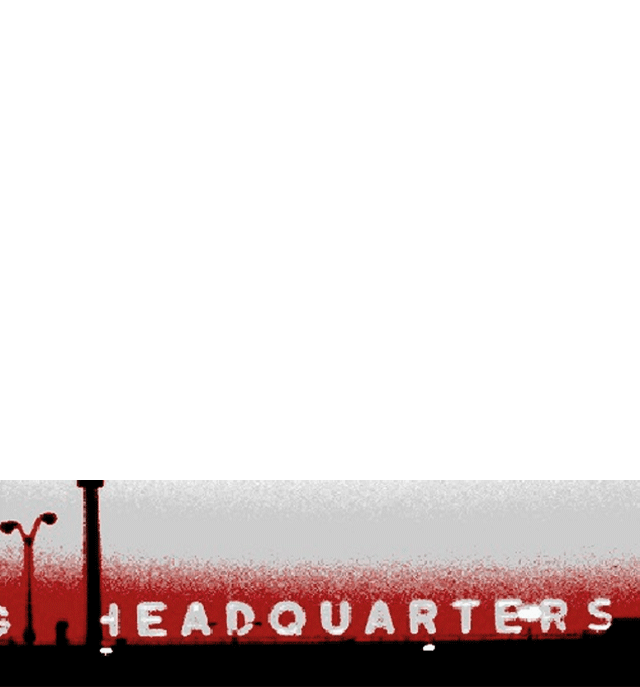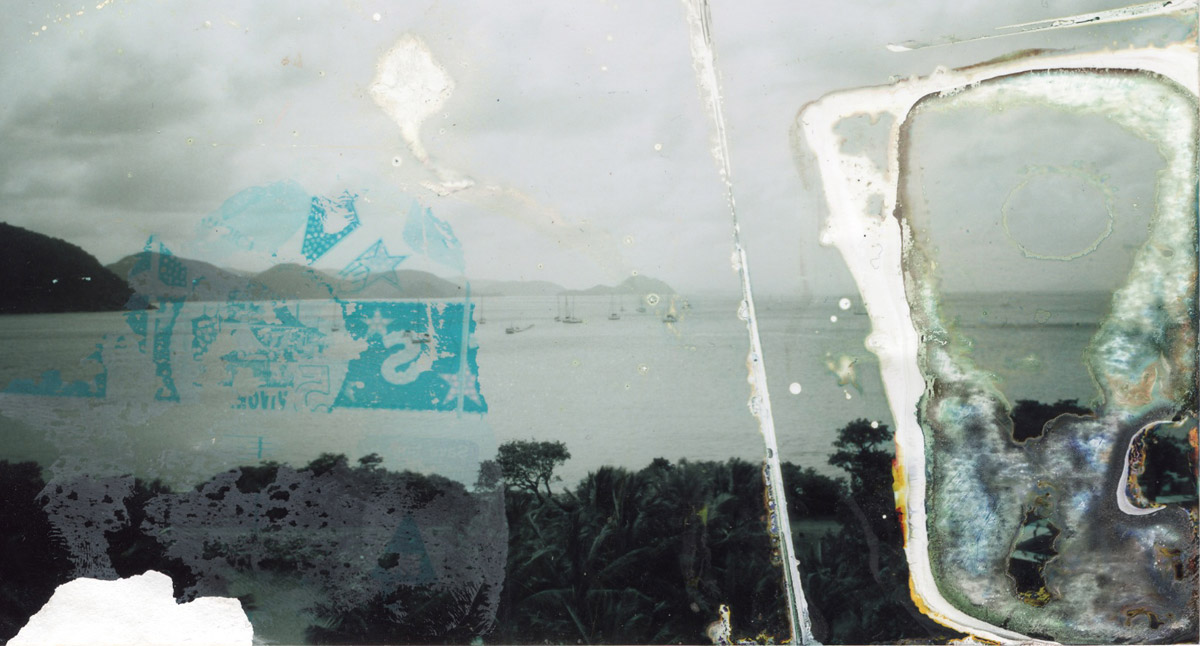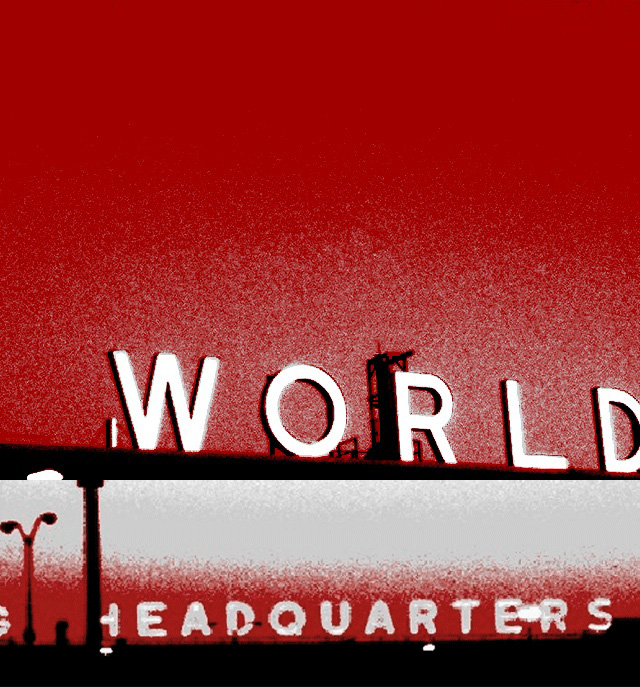A Hero of Deconstruction
archive: review-A Hero of Deconstruction: A Hero of Deconstruction
from The London Times Sunday magazine
“David Carson printed a dull article as unfathomable symbols. Readers loved it, Lewis Blackwell explores the work of graphic design genius”
As you read this, David Carson is probably in a hotel room in a strange city somewhere preparing for yet another show. From New York to London, Brussels to New Orleans, the tour goes on. His lifestyle echoes that of a rock star, or religious cult leader. But he is something more seminal to this media-saturated age of ours. Carson is a graphic designer.
Once this job description had all the glamour of the technician that it largely described-someone who helped things appear on the right bit of paper. But graphics has changed. In the Eighties, the designer rose to prominence, a figure invested with the authority to remake the modern world.
In their work designers celebrated the Self, trumpeted individualism and led the obsession for consumerables whose value was multiplied through a label. Designer jeans, designer perfume, designer restaurants-the hand or signature of the designer-creator came to be an important (if often spurious) mark of quality. In the past few years, we may have dismissed Eighties style, but there seems little lessening of the desire for creative heroes. In an age when values are at best questioned, at worst entirely shot away, those who can make up their own rules and pitch them out there have the firm basis of a career. Appearance is everything. Until you buy a new one.
Graphic design, which didn’t quite peak in the Eighties, has arrived. Now that everybody has an ironic post-modernist take on their information sources, the graphic designer is pitched as high priest at the altar of mass-communication. Press conferences are held to launch minor tweakings of corporate logos, while lavish awards cram the calendar, showering honour on the makers of the media.
But fewcan hope to catch the wave as David Carson has done. Perhaps it is because he is a one-time professional surfer-reputedly reaching a peak of number eight in the world-that he seems to have an instinctive grasp of the forces behind the times. Perhaps it is also that he is almost entirely self-taught, and thus escaped having dinned into him the “right way of doing things” which inevitably congeals into dogma, the destiny of which is to be torn apart.
Carson has shown excellent timing and an ability to stay at the adge: from the early Eighties when he learnt how to design a magazine as he went along, knocking out a 200-page skateboarding magazine in the evenings after teaching at high school near San Diego, through the years of catching attention with offbeat publishing, to the recent years of stardom and a queue of clients across print, advertising, television and film.
While rivals might question his success, and often speak cynically of Carson’s ability to get talked about, they have to admit he does have something-the indefinable eye. Even his enemies admit the man has talent. The distinct difference of Carson’s work, and its wildfire effect on the imagination of young designers, has ensured that he is applauded or attacked as the art director/designer of this era.
In the radical vision of Carson’s graphics, a generation of designers has a new creed to follow. This involves, to describe the work crudely, free-form pages and films, beautifully difficult-to-read typography, distressed images and eclectic multi-cultural sources of material, all working to spin a richly seductive form for his client’s communications-messages which range from the latest Microsoft poster campaign to the Giorgio Armani magazine, anti-smoking ads, short films , books and commercials.
Carson’s sold-out speaking tour coincides with the launch of Second Sight: grafik design after the end of print (Laurence King, f35 /f25), which attempts to reveal the theory behind the seemingly unruly nature of all this output. The first book on his work, The End Of Print , sold 120,000 copies worldwide-not enough to begin paying out the advance of a John Grisham novel, but unprecedented for a graphic design book.
As the author, or collaborator, on both books, I am scarcely the best person to assess their merit-but can at least claim an inside knowledge of their making and the motives of the man behind the work. With the first book, we unintentionally caught the vogue for “end-ism” (we were at the beginning of the rash of books titled “The End Of…”) , noting how the growth of media was changing print and how it was stimulating radical questions about what we read and how we want to see it. With the latest book we looked for the forces behind this design that runs so counter to the reasoning of traditional practice.
Carson is an intriguing mix of innocence and experience. He has a sociology degree and has worked in design for a decade. Yet he still displays remarkable gaps in his knowledge of design history, or indeed of some basic craft practices. Younger designers often assume he is a child of the digital era, where the technology invites play with type and images, but in fact his approach was forged before moving on to the computer. He spends time finding and saving junked materials, taking photographs, and playing with surfaces outside of the computer environment. His work has more in common with fine artists-notably Abstract Expressionists such as Pollock and Rothko-than it has with other designers. He only really uses one software program, whereas the typical young graphic designer tends to dip in and out of a handful.
Instead of having all the answers, Carson’s work is driven by asking questions. In an often highly self-conscious manner, his layouts and films are full of details that make you aware of the surface of the page or screen, make you aware of the medium and of its rules-rules which Carson takes as things to be twisted in his intuitive search for new ways of doing things.
This idea of intuition is at the core of the work. In a rejection of the rationalism behind Modernist design, he has embraced intuition as being a long-underrated virtue of creative work. In this he is tapping into a deeply unfashionable area of philosophy, one which connects with the quasi-spiritual approach of Henri Bergson at the turn of the century, and also links with the current vogue for Outsider Art, or Art Brut.
Carson is not expecting a warm reception from the “design industry” for such an attitude. With graphic designers often desperate to suggest to likely clients that their work is some kind of soft science, almost guaranteed to deliver measurable improvement in a company’s performance, the last thing they need is a contemporary design guru saying good design is at its best as a personal, gut-feeling, a mixing of self-expression into public messages.
But such words strike a deeply resonant chord with designers as yet free of corporate pressures. They can sense that Carson’s approach touches the very reason why they do the job in the first place: to try and shape the world in some way, so that it enriches life in a broader sense than just delivering results on a company’s bottom line.
For the general viewer-or perhaps you and I-the appeal of the work is, at first sight, simply that it is refreshingly different. He challenged conventions about readability and about page structure, even magazine structure. This leads to the removal of page numbering, the subversion of descriptive contents pages, even the abandonment of beginning at the beginning (one magazine started in the middle and worked out in both directions, with some articles ending on an associated internet site).
These were pyrotechnics of from, rarely supported by the content of what were otherwise fairly tame editorial products. In his frustration with yet another dull article in the magazine Ray Gun he went so far as to produce it in an entirely unreadable typeface of symbols. Interestingly, this caused no apparent backlash from readers, but only won more admiration.
In moving away from niche magazines and into the world of international advertising, and more heavyweight work, Carson is running the risk of losing control. His most influential magazine work came out of a process that saw him send the magazine to the printer without recourse to the editor or publisher. But such freedom is not possible when you are helping present a global brand to its marketplace in a dozen different languages, with a dozen different corporate divisions all bidding to make their mark.
Only in creating his own book, or in some of his smaller one-off jobs and teaching roles, dose Carson now get the kind of freedom that has turned on a generation of graphic designers. Whatever his next move, though, one thing is sure that he has been a major influence in creating a tidal force of change in the look and logic of contemporary graphics. Next time you like the look of something but can’t at first quite work out what it is saying, thank David Carson. Or not.
Lewis Blackwell is head of Getty Images.
from The London Times Sunday magazine
“David Carson printed a dull article as unfathomable symbols. Readers loved it, Lewis Blackwell explores the work of graphic design genius”
As you read this, David Carson is probably in a hotel room in a strange city somewhere preparing for yet another show. From New York to London, Brussels to New Orleans, the tour goes on. His lifestyle echoes that of a rock star, or religious cult leader. But he is something more seminal to this media-saturated age of ours. Carson is a graphic designer.
Once this job description had all the glamour of the technician that it largely described-someone who helped things appear on the right bit of paper. But graphics has changed. In the Eighties, the designer rose to prominence, a figure invested with the authority to remake the modern world.
In their work designers celebrated the Self, trumpeted individualism and led the obsession for consumerables whose value was multiplied through a label. Designer jeans, designer perfume, designer restaurants-the hand or signature of the designer-creator came to be an important (if often spurious) mark of quality. In the past few years, we may have dismissed Eighties style, but there seems little lessening of the desire for creative heroes. In an age when values are at best questioned, at worst entirely shot away, those who can make up their own rules and pitch them out there have the firm basis of a career. Appearance is everything. Until you buy a new one.
Graphic design, which didn’t quite peak in the Eighties, has arrived. Now that everybody has an ironic post-modernist take on their information sources, the graphic designer is pitched as high priest at the altar of mass-communication. Press conferences are held to launch minor tweakings of corporate logos, while lavish awards cram the calendar, showering honour on the makers of the media.
But fewcan hope to catch the wave as David Carson has done. Perhaps it is because he is a one-time professional surfer-reputedly reaching a peak of number eight in the world-that he seems to have an instinctive grasp of the forces behind the times. Perhaps it is also that he is almost entirely self-taught, and thus escaped having dinned into him the “right way of doing things” which inevitably congeals into dogma, the destiny of which is to be torn apart.
Carson has shown excellent timing and an ability to stay at the adge: from the early Eighties when he learnt how to design a magazine as he went along, knocking out a 200-page skateboarding magazine in the evenings after teaching at high school near San Diego, through the years of catching attention with offbeat publishing, to the recent years of stardom and a queue of clients across print, advertising, television and film.
While rivals might question his success, and often speak cynically of Carson’s ability to get talked about, they have to admit he does have something-the indefinable eye. Even his enemies admit the man has talent. The distinct difference of Carson’s work, and its wildfire effect on the imagination of young designers, has ensured that he is applauded or attacked as the art director/designer of this era.
In the radical vision of Carson’s graphics, a generation of designers has a new creed to follow. This involves, to describe the work crudely, free-form pages and films, beautifully difficult-to-read typography, distressed images and eclectic multi-cultural sources of material, all working to spin a richly seductive form for his client’s communications-messages which range from the latest Microsoft poster campaign to the Giorgio Armani magazine, anti-smoking ads, short films , books and commercials.
Carson’s sold-out speaking tour coincides with the launch of Second Sight: grafik design after the end of print (Laurence King, f35 /f25), which attempts to reveal the theory behind the seemingly unruly nature of all this output. The first book on his work, The End Of Print , sold 120,000 copies worldwide-not enough to begin paying out the advance of a John Grisham novel, but unprecedented for a graphic design book.
As the author, or collaborator, on both books, I am scarcely the best person to assess their merit-but can at least claim an inside knowledge of their making and the motives of the man behind the work. With the first book, we unintentionally caught the vogue for “end-ism” (we were at the beginning of the rash of books titled “The End Of…”) , noting how the growth of media was changing print and how it was stimulating radical questions about what we read and how we want to see it. With the latest book we looked for the forces behind this design that runs so counter to the reasoning of traditional practice.
Carson is an intriguing mix of innocence and experience. He has a sociology degree and has worked in design for a decade. Yet he still displays remarkable gaps in his knowledge of design history, or indeed of some basic craft practices. Younger designers often assume he is a child of the digital era, where the technology invites play with type and images, but in fact his approach was forged before moving on to the computer. He spends time finding and saving junked materials, taking photographs, and playing with surfaces outside of the computer environment. His work has more in common with fine artists-notably Abstract Expressionists such as Pollock and Rothko-than it has with other designers. He only really uses one software program, whereas the typical young graphic designer tends to dip in and out of a handful.
Instead of having all the answers, Carson’s work is driven by asking questions. In an often highly self-conscious manner, his layouts and films are full of details that make you aware of the surface of the page or screen, make you aware of the medium and of its rules-rules which Carson takes as things to be twisted in his intuitive search for new ways of doing things.
This idea of intuition is at the core of the work. In a rejection of the rationalism behind Modernist design, he has embraced intuition as being a long-underrated virtue of creative work. In this he is tapping into a deeply unfashionable area of philosophy, one which connects with the quasi-spiritual approach of Henri Bergson at the turn of the century, and also links with the current vogue for Outsider Art, or Art Brut.
Carson is not expecting a warm reception from the “design industry” for such an attitude. With graphic designers often desperate to suggest to likely clients that their work is some kind of soft science, almost guaranteed to deliver measurable improvement in a company’s performance, the last thing they need is a contemporary design guru saying good design is at its best as a personal, gut-feeling, a mixing of self-expression into public messages.
But such words strike a deeply resonant chord with designers as yet free of corporate pressures. They can sense that Carson’s approach touches the very reason why they do the job in the first place: to try and shape the world in some way, so that it enriches life in a broader sense than just delivering results on a company’s bottom line.
For the general viewer-or perhaps you and I-the appeal of the work is, at first sight, simply that it is refreshingly different. He challenged conventions about readability and about page structure, even magazine structure. This leads to the removal of page numbering, the subversion of descriptive contents pages, even the abandonment of beginning at the beginning (one magazine started in the middle and worked out in both directions, with some articles ending on an associated internet site).
These were pyrotechnics of from, rarely supported by the content of what were otherwise fairly tame editorial products. In his frustration with yet another dull article in the magazine Ray Gun he went so far as to produce it in an entirely unreadable typeface of symbols. Interestingly, this caused no apparent backlash from readers, but only won more admiration.
In moving away from niche magazines and into the world of international advertising, and more heavyweight work, Carson is running the risk of losing control. His most influential magazine work came out of a process that saw him send the magazine to the printer without recourse to the editor or publisher. But such freedom is not possible when you are helping present a global brand to its marketplace in a dozen different languages, with a dozen different corporate divisions all bidding to make their mark.
Only in creating his own book, or in some of his smaller one-off jobs and teaching roles, dose Carson now get the kind of freedom that has turned on a generation of graphic designers. Whatever his next move, though, one thing is sure that he has been a major influence in creating a tidal force of change in the look and logic of contemporary graphics. Next time you like the look of something but can’t at first quite work out what it is saying, thank David Carson. Or not.
Lewis Blackwell is head of Getty Images.








Comments are closed.